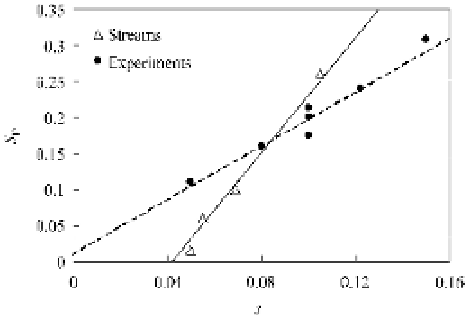Environmental Engineering Reference
In-Depth Information
streams and the experiments. The line for the mountain streams is much steeper than the line for the
experiments. One reason for the difference is that there are big boulders in the streams but the size of big
particles in the experiment is confined by the material used. The higher the bed slope, the greater is the
flow energy needing to be consumed per length of the channel. To maintain a stable channel, step-pools
are needed to consume the flow energy in the case of high bed slopes. Therefore, the development degree
of step-pools is proportional to the bed slope.
Fig. 3.30
Development degree of a step-pool system,
S
P
, as a function of the average bed slope
3.3.2.2
Experimental Studies
Many experimental studies have been conducted on the development of step-pool systems (Rosport,
1994; Grant et al., 1990). An experiment was done in a Plexiglas tilting flume 5-m long, 8-cm wide, and
20-cm high (Wang et al., 2004). The slope was in the range of 0.05-0.15 and water discharge varied from
0.1 l/s to 1.5 l/s. The discharge was measured with a triangular notch weir at the entrance. Three size
distributions of gravel and sand mixtures were used in the experiments, as shown in Fig. 3.31. The
difference between the gravel and sand mixtures lies in the existence of some large gravel and cobbles.
For each experiment, a 10-cm thick layer of the sand-gravel mixture was initially put in the flume and
formed a flat channel bed. Clear water at a given discharge flowed and scoured sediment from the
channel bed. Gradually a relatively stable step-pool system developed and the erosion rate reduced to a
minimum. The flow depth increased and flow velocity decreased following the development of the
step-pool system.
Fig. 3.31
Size distributions of sand-gravel mixtures used in the experiments on step-pool formation (after Wang et
al., 2004)







Search WWH ::

Custom Search